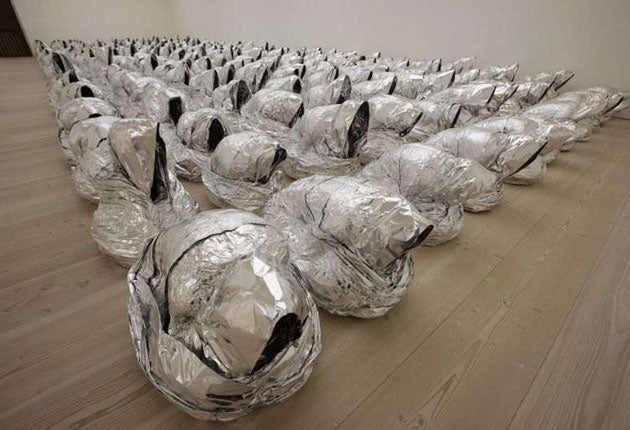Unveiled: New Art from the Middle East, Saatchi Gallery, London
Two cultures, both united and divided by their beliefs and histories, are laid bare in an impressive new exhibition

It often pays to go through exhibitions backwards, the Saatchi Gallery's Unveiled being a case in point. Its final work is a piece called Flag #19 by Sara Rahbar, a tattered take, in Persian brocade, on the Stars and Stripes.
Whatever else it may be about – accompanying literature suggests "protest against the current wars" – Flag #19 is about Jasper Johns. Which is to say its subject is American cultural hegemony, the way in which the US flag and Johns's Flag have become twin emblems of world domination. Whether Rahbar's attitude to this is celebratory or critical is hard to say. Her Flag is pretty and battle-scarred; or, maybe, tacky and clapped out, depending on how you look at it.
It is a good place to start a visit to an extraordinarily good show. Unveiled is an exhibition of contemporary Middle Eastern art, Rahbar being Iranian. Or rather, like her flag, not quite. Born in Tehran in 1976, she has been in exile in Britain and America for most of her life, which means she is both a victim of Western domination and complicit in it. She is not alone in this. Only eight of the 19 artists in this show actually live in the Middle East, and only two of the seven women. (For them, presumably, "unveiled" has a more specific meaning.) The rest – notionally Algerian, Lebanese, Iraqi or Palestinian – make their art in Paris or Berlin or New York.
So Rahbar's flag tells an uneasy truth that runs throughout this show. In these globalised times, to be an artist is to be a Western artist, by which I mean that the traditions and styles and materials and techniques of the work in Unveiled are Euro-American ones. If the devil has all the best tunes, the Great Satan has also cornered the market in visual representation. A couple of Unveiled's participants play games with Middle Eastern art history – Hayv Kahraman, for example, who makes blown-up Persian miniatures in Phoenix, Arizona – but the preoccupations of these young painters and sculptors are the same as they would be if they had gone to art school in London. (And several of them did.)
Whether these two facts are connected – whether the power of the work in Unveiled suggests that the act of making it had an extra charge for the makers concerned – I cannot say. Nor can I tell you if the preponderance of painting in the show reflects a parallel bias in contemporary Middle Eastern art-production. But I can say that there are few false steps in this exhibition – that the work in it is uncommonly grown-up, well-made, passionate and strong.
Like Rahbar, Ahmed Alsoudani, born in Baghdad, lives in America. His practice also resembles hers in looking for a moment in art history from which to start again. If Rahbar found Johns circa 1954, Alsoudani taps into a more generic modernism. A vast, untitled pastel-on-paper piece, six square metres in size, has echoes of both Neue Sachlichkeit and Abstract Expressionism. Its most obvious ancestor, though, is Guernica. Like Picasso's epic, Alsoudani's monochrome palette takes on photography to broadcast an uncensored reportage of war. Its abstract narrative tells a story that cannot be told rationally.
Tala Madani does the same thing in a different way, the battle in her case being that of the sexes. The stack of calligraphic, L-shaped orange forms in Tower Reflection suggest robed men kneeling, perhaps in acrobatic formation, or maybe in prayer. Stubbled chins and black hair mark them as Tehran machos, although the shocking pink tongue of one protrudes to lick the arse of another. You can see why Madani, an Iranian woman, might choose to live and work in Amsterdam.
As I've said, there is a preponderance of painting in Unveiled, perhaps because the great moments of Middle Eastern modernism – the Khartoum School of the 1960s, say – were painterly ones. This may also explain why the painters in this show do not seem to have suffered the crisis of confidence of their Western counterparts. But while the work feels grounded in the past, it can hardly be accused of being backward-looking.
Take Kader Attia's Ghost. A room-sized installation piece, Ghost consists of what look from the door like giant baked potatoes. Seen from the room's far end, these turn out to be moulded silver-foil figures of Arab women at prayer, their faces empty sockets. Small differences between the 80 or so kneeling shapes invest them with a semblance of personality, some mournful, some intent, others gossipy or distracted. Yet what they finally are is vacant, their crouching postures and kitchen-wrap robes twin symbols of subservience.
Marwan Rechmaoui, too, goes for large-scale installations, here inspired by his native Beirut. Rechmaoui's floor-based rubber relief map of the city calls to mind Vauban's 17th-century models of French garrison towns. Spectre is a recreation of the artist's Corbusian apartment block, abandoned in 2006 during the conflict with Israel. Both works evoke a moment in the Middle East when modern – which is to say, Western – rationalism seemed about to take hold, before fundamentalists from both East and West began their attacks, and turned back the clock by a century.
Saatchi Gallery, London SW3 to 6 May. Admission free
Join our commenting forum
Join thought-provoking conversations, follow other Independent readers and see their replies
Comments